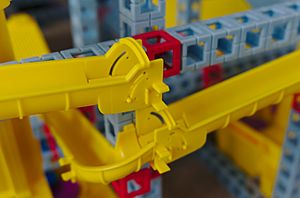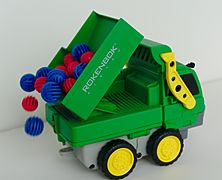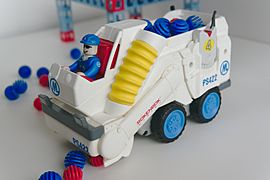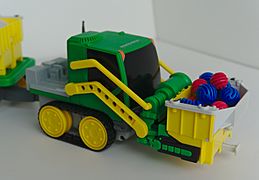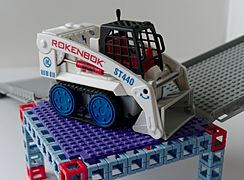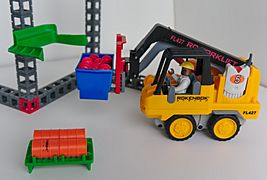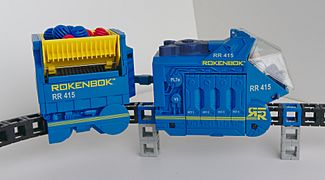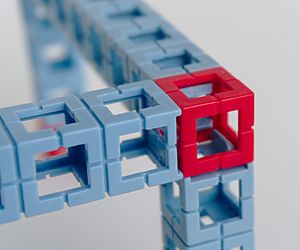Kid Spark Education facts for kids
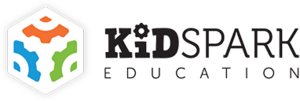 |
|
| Nonprofit organization | |
| Genre | STEM Education Products |
| Predecessor | Rokenbok Education |
| Founder | Paul Eichen |
| Headquarters |
,
United States
|
| Products | Mobile STEM Labs |
Kid Spark Education is a special organization that helps kids learn about science, technology, engineering, and math (STEM). They create affordable "Mobile STEM Labs" and learning plans for schools and youth groups. This organization started in 1995 as the Rokenbok Toy Company. It was founded by Paul Eichen in the United States. The first Rokenbok toys came out in 1997.
In 2015, the company changed to become a nonprofit organization. This means they focus on helping people rather than making money. They then finished making their first four classroom products, called Mobile STEM Labs. Since then, Kid Spark Education has put these labs in schools across more than 22 states.
Kid Spark Education works on creating fun ways for students from kindergarten to 8th grade to learn about technology and engineering. They also give free or cheaper programs to schools that help kids who might not have many opportunities. A big part of their work is teaching teachers and youth leaders how to be great STEM mentors.
Contents
The Story of Kid Spark Education
The Rokenbok Toy Company began in 1995, started by Paul Eichen in the United States. Around 2008, many toy stores closed. Because of this, the company started selling almost all its toys online. They made videos for YouTube to show off their products. These videos also showed how different Rokenbok sets could be put together to make bigger creations.
In 2015, the company officially became a nonprofit organization. This change helped them focus more on education. Around 2017, they stopped making most of their chutes and vehicles. Only the Maker ROK-Bot continued to be produced.
What Was Rokenbok?
Rokenbok was an educational toy system. It combined building pieces that fit together with cool vehicles controlled by infrared signals. You could always add more pieces to your Rokenbok system. Some of the building surfaces even had round studs, which meant they could connect with Lego bricks!
Rokenbok was great for playing with friends. Up to four players could control as many as eight vehicles at the same time. Each player could drive their own vehicle. The controllers looked a lot like those for video game consoles. They had a D-pad for moving and special buttons for other actions. Rokenbok toys encouraged kids to work together and play in a positive way. They did not use any characters from movies or cartoons.
Rokenbok Vehicles
The first vehicles were for construction. These included the Loader, Dozer, and TransGripper with a Cargo Trailer.
Later, "Metropolitan" vehicles were added. These were the Power Sweeper, Skip Track, and Emergency Speedster.
In 2000, the Elevator and the Monorail system were released. The Tower Crane started being made in 2001.
Rokenbok updated its product line in 2002. The new products looked more like real construction sites. They also had more realistic colors. The Loader and Dozer got new colors. New vehicles like the Forklift, ROK Lift, and Night Shift Trailer were also introduced. A simpler version of the loader, called the Dump Truck, was made for younger kids.
For a short time, Rokenbok also made a Police Defender and a Fire and Rescue set.
When they started making more engineering-focused products, they released the X2 Power Unit. This unit could power different machines, like drawbridges and lifts.
The last group of vehicles included the Dump Truck, Loader, Dozer, Power Sweeper, X2 Power Unit, Forklift, ROK Lift, Night Shift Trailer, and Skip Track.
Rokenbok Action Accessories
ROK-Lift
The Power ROK-Lift was like an elevator for Rokenbok. It was used to carry many ROK balls to the top of a tower. The ROK-Lift had a button on the front. When an RC vehicle bumped this button, the lift would go up. It used gears that moved along special "Elevator Racks." Once the lift reached the top, its bins would automatically dump the ROKs into a container or chute. Then, the lift would go back down.
Night Shift Trailer
The Night Shift Trailer was a trailer that any Rokenbok vehicle could pull. You could drive it to where you needed it. This trailer looked like a highway construction sign. It was meant to guide RC vehicles away from a pretend construction area. The sign had two LED flood-lights and two LED direction lights. These lights could point right, left, or both ways. You turned the lights on by hand. This trailer was often given as a free extra with bigger Rokenbok sets.
Motorized Conveyor
The Motorized Conveyor was a device that moved ROK balls upwards. It was about 12 inches long and 4 inches wide. The conveyor used a special sensor to know when ROKs were at the bottom. This sensor acted like an on/off switch. It had spinning wheels with grooves that helped move the ROKs and stop them from getting stuck. The first Conveyor used an A/C plug. It needed a "command deck" to work. Later, Rokenbok made a battery-powered version. This meant no wires and saved electricity. The Conveyors came in orange and brown, or red and yellow colors.
Action Sorter
The Action Sorter helped direct ROK balls in four different ways. One way sorted them by color. Another path led to a tipple underneath. The other two paths joined together and led to an output. This output allowed you to build your own custom chutes.
Silo
The Silo was part of the Pump Station Start Set. It was also available as the Piston Plant for those who already had a different start set. The silo used a vehicle driving back and forth to push a hanging arm. This arm would raise and lower bins above. These bins would move ROK balls along two different paths. One path would quickly dump the ROKs into a chute below. The other path would slowly release ROKs from one corner.
Rokenbok Building System
Beams and Blocks
The Rokenbok building system uses beams and blocks that fit together. You can use them to create all sorts of structures. There are two main lengths of beams: one is seven blocks long, and the other is three blocks long. These beams have tabs on their ends that connect to the blocks. Since beams are similar to blocks but longer, you can connect a beam at any point along its length. These beams and the ROK balls are still used by Kid Spark Education today.
ROKs and Chute Systems
Rokenbok had a cool chute system that you could build yourself. This system included the ROK Motorized Conveyor, hoppers, sorting chutes, and trap door chutes. There were also many other curved pieces. Hoppers would send the ROK balls in one of two directions, depending on where the balls fell. Sorting chutes were clever: they had a hole that red ROKs could fall through, but blue ROKs couldn't, because they were different sizes. Trap door chutes had a door that you could open or close. These were used to end a chute system. Kid Spark Education now only sells ROK balls. All the other chute accessories are no longer made.
Monorail Train System
The monorail system came out in 2000. It used the same beams and blocks as the regular Rokenbok building system. There were also curved and "s" shaped beams. These helped you create turns or sloped tracks for the train to go up and down. Rokenbok also made "riser beams." These were two blocks long and had tabs on only one end. They were used to support the track. This is because the monorail train hangs down over the sides of the track for balance. This design blocked the side connection holes on the regular beams.
How Rokenbok Was Controlled
The Rokenbok vehicles, crane, and elevator were controlled using special controllers. These controllers looked a lot like those for Xbox or PlayStation. The first controllers were wired. You had to press a button to choose which vehicle number you wanted to control.
Later, they released the "Rok-Star" controller. This was a wireless controller. With it, players could choose a vehicle by pointing a red light at the vehicle's receiver. This was a big improvement! It meant there was no limit to how many vehicles one player could control. It also meant more players could play at once.
The control pads had three main parts. On the left was the four-way directional pad, or D-pad. This controlled how the vehicles moved. In the middle of each control pad was a button. Players pressed this button to switch between the available vehicles. On the older controllers, you could control up to eight vehicles. You chose them by setting an LED light to a number from 1 to 8. On the ROK-Star controller, there was a large "R" button. You pressed and held it, then pointed it at a ROK-Star vehicle to select it.
On the right side, there were four function buttons: A, B, X, and Y. These buttons did different things for each vehicle. The ROK-Star controller also had buttons to make siren sounds and change their pitch. It could also make back-up alarms. Above each handle, at the top of the control pad, were two shoulder buttons. The left shoulder button would switch you back to the last vehicle you used. The right shoulder button would make your vehicle go slower. The D-pad and shoulder buttons worked the same way for every vehicle.


